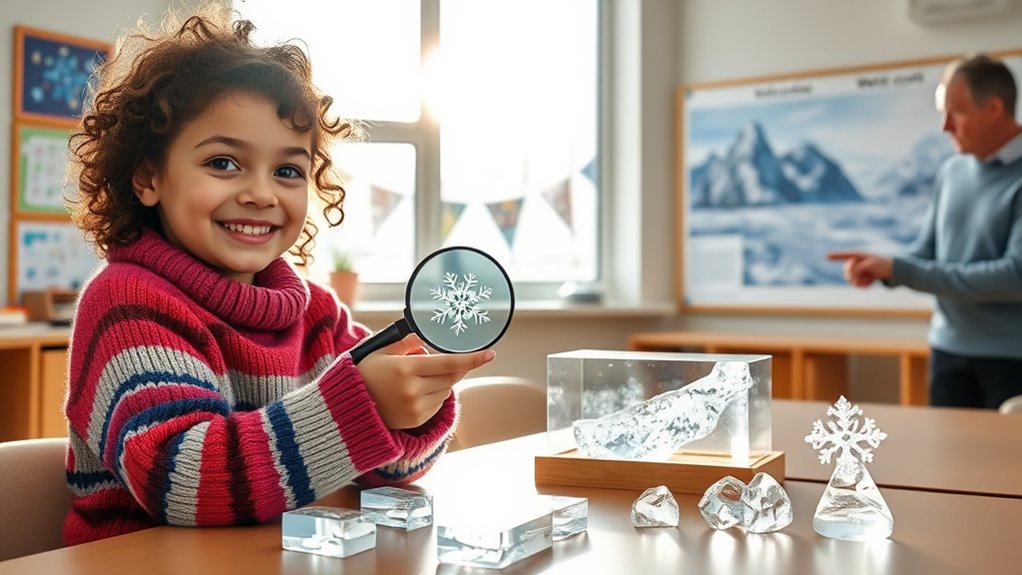To teach kids the science behind snow and ice, show how tiny water vapor crystals form into snowflakes through cooling and humidity. Explain that each snowflake is unique because of changing conditions during its growth. Use simple experiments, like growing sugar or salt crystals, and compare materials that conduct heat differently to demonstrate melting and freezing. If you keep exploring, you’ll discover even more fascinating facts about how snow and ice develop and change.
Key Takeaways
- Explaining how snowflakes form from water vapor condensing into unique, hexagonal ice crystals illustrates crystal growth.
- Demonstrating thermal conductivity with materials like metal and foam shows how heat transfer causes snow to melt or stay solid.
- Highlighting the environmental factors affecting snowflake shapes helps kids understand snow diversity.
- Using simple experiments, like growing sugar or salt crystals, makes the science of crystal formation engaging and tangible.
- Visual aids such as snowflake photographs and melting demonstrations clarify the processes of ice formation and melting.

Have you ever wondered why snowflakes are so unique or how ice forms in winter? When you start exploring these questions with kids, you’re opening the door to fascinating science. The process begins with crystal formation, which is at the heart of how snowflakes develop. Each snowflake starts as a tiny ice crystal that forms when water vapor in the air cools and condenses onto a tiny particle, like dust. Because the temperature and humidity levels vary, each crystal grows in a different way, leading to the incredible diversity of snowflakes. Explaining that ice crystals grow in a hexagonal shape helps kids visualize how the molecules arrange themselves into structured patterns. You can show them pictures or even make simple models with sugar or salt to demonstrate how crystals form and grow.
Understanding thermal conductivity is key to grasping how ice and snow change over time. Thermal conductivity measures how well a material transfers heat. In the case of snow and ice, it explains why snow melts or how ice stays cold. When snow is exposed to warmth—say, from the sun or a warm hand—heat moves from the warmer surroundings into the snow, causing the ice crystals to melt. Because snow has a low thermal conductivity, it doesn’t transfer heat quickly, which helps it stay solid for longer in cold weather. Explaining this concept in simple terms can help kids understand why snow can linger on the ground even when the temperature rises slightly. You might compare thermal conductivity to how well a sponge absorbs water—some sponges soak up quickly, while others do so slowly. Snow’s low thermal conductivity means it doesn’t easily transfer heat, which explains why it stays cold and solid even during brief warm spells.
You can also demonstrate these ideas with hands-on experiments or visual aids. For crystal formation, grow salt or sugar crystals in the kitchen to show how crystals develop over time. For thermal conductivity, use different materials like metal, plastic, and foam to see how they conduct heat when touching a warm object. These activities make the abstract concepts tangible and engaging for kids. Additionally, understanding cybersecurity vulnerabilities related to digital tools can help them stay safe online while exploring science. By exploring crystal formation and thermal conductivity, you help kids see the beauty and complexity of winter’s icy phenomena. They’ll understand that snow and ice aren’t just simple frozen water but intricate systems governed by scientific principles. Teaching these ideas encourages curiosity, making winter’s chill an exciting opportunity to learn about the natural world.
Frequently Asked Questions
How Does Snow Form in the Atmosphere?
You might wonder how snow forms in the atmosphere. It starts with cloud formation, where warm air rises and cools, causing atmospheric moisture to condense into tiny water droplets or ice crystals. As more moisture joins, these crystals grow and stick together. When they become heavy enough, they fall as snow. So, snow forms when atmospheric moisture condenses into ice within clouds, then drops to the ground as snowflakes.
Why Does Ice Float on Water?
Think of ice as a buoyant boat on water’s surface. Due to density differences, ice is less dense than liquid water, so it floats. This follows buoyancy principles, where objects less dense than the fluid they’re in will rise. You can relate it to a life jacket keeping you afloat—ice’s unique molecular structure causes it to be lighter than water, making it naturally float and insulate aquatic life during winter.
What Causes Snowflakes to Have Different Shapes?
You see, snowflakes have different shapes because of variations in crystal symmetry and their hexagonal structure. As water vapor freezes, it forms ice crystals with a hexagonal shape, but environmental factors like temperature and humidity influence how they grow. These conditions cause the crystals to develop unique patterns, leading to the incredible diversity of snowflake shapes. So, each snowflake’s design is a reflection of the specific conditions it experienced during formation.
How Does Temperature Affect Ice Melting?
When the temperature rises, ice undergoes a phase shift from solid to liquid, causing it to melt. Higher temperatures increase thermal conductivity, allowing heat to transfer more efficiently into the ice. This accelerates melting by breaking the bonds holding the ice molecules together. So, the warmer it gets, the faster your ice melts because heat flows into it more readily, triggering the phase transition from solid to water.
Can Snow and Ice Exist at the Same Time?
They say, “Where there’s smoke, there’s fire,” but in weather, snow and ice can coexist. At certain temperatures, atmospheric moisture forms clouds with snowflakes, while nearby surfaces stay icy. Cooler air prevents melting, so snow stays on the ground even as ice forms. You’ll often see this during winter storms, where snow accumulates and icy patches develop simultaneously, proving nature’s complex balance of cloud formation, temperature, and moisture.
Conclusion
Now that you’ve learned the science behind snow and ice, you’re ready to share this wonder with kids. Explaining how water turns to ice or how snow forms makes the world feel more magical and real. Remember, teaching is a two-way street—your enthusiasm can spark curiosity in little minds. So, don’t let the opportunity slip through your fingers; seize it and watch their eyes light up with awe. After all, knowledge is the key to unveiling endless wonder.









